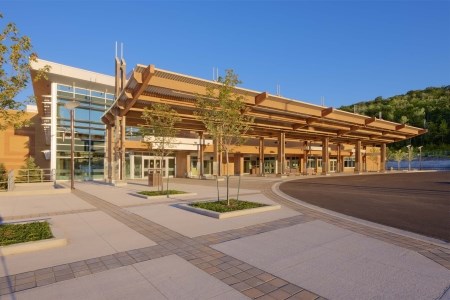Evans Bertrand Hill Wheeler Architecture Inc. accomplished a lot of firsts as they brought the new North Bay Regional Health Centre to fruition.
The long-standing North Bay firm has served the region for almost 55 years. Eighteen people work under five architects, three of whom are emeritus. Their collective knowledge and accumulated expertise made them an exceptional choice to head the $350-million hospital project. As the prime consultants, they hired, organized and coordinated about 18 to 20 different consulting firms, in addition to their client’s specialty sub-consultants.
It was the 23rd-largest construction project in Canada when the project began in 1997, and the largest in northeastern Ontario, according to lead architect Brian Bertrand, a 25-year veteran of renovating hospitals.
“The whole focus of the hospital and its design-orientation revolved around patient-focused care and creating a healing environment,” he said.
Now, as the finishing touches are applied to the 754,938-square-foot facility, and employees prepare to move in at the end of January 2011, Bertrand looks back on the project as an amazing opportunity for educational growth.
“This has to rank as one of the most exciting projects I’ll ever do in my career.”
The firm was also the recipient of three Wood WORKS! Awards for 2010, which recognizes the decision to design and build with wood in commercial, industrial or institutional settings.
The design and construction of the regional health centre set the bar, garnering international attention. It is the first time in Canada a mental health facility has been co-located with an acute care general hospital.
The new design moves away from the old institutional style of ward rooms, and long, narrow corridors. The new facility now features smaller lodges containing up to 16 patients, single bedrooms, shared areas, high ceilings, and lots of natural light and wood.
Challenges like the food delivery model had to be addressed because the mental health centre had a two-month food cycle and the acute care centre worked in a two-week cycle. Now, patients can prepare and cook their own food, have bulk service with choices, or receive tray service. They can also choose to eat alone or with others.
The use of heavy timber as a structural element in a B2 occupancy (care and treatment) was another first, as well as the fact that the building is Leadership in Energy and Environmental Design (LEED) certified, a green building rating system that advocates sustainable practices. This system provided a framework for all parties to adhere to, creating more collaboration.
“It paid dividends in terms of fresh air in every room, major capital cost savings, major annual cost savings and planning for the future,” Bertrand said.
As well, mechanical systems have been structured for a co-generation plant later on.
The use of wood was a collective decision, partially for its healing qualities and to support the northern softwood industry.
With the number of forestry mills throughout Northern Ontario, Bertrand said it is part of people’s fabric to relate to wood. “People relate to its tactile qualities,” he said. “You can smell it, touch it, see it. It is a wonderful product.”
Some of the heavy timber columns and beams have concealed fastenings, while others were intentionally exposed, he added, alluding to the railway heritage of the area.
Another first was the new model for infection control that had to be implemented when SARS hit. They had to retool almost every department to deal with negative air pressure issues, containment rooms and isolation rooms.
In 2005, the Ontario government implemented an alternative financing and procurement process, which uses private financing to ensure on-time and on-budget infrastructure delivery. This new model resulted in the North Bay Regional Health Centre becoming a modified DBFM (Design, Build, Finance and Manage).
Although it was a long haul, Bertrand equates the process to surfing on one massive wave.
“If you were too far behind the wave, you could never catch up getting information to the subs, and if you were too far ahead, you’d get crushed by the wave. It was a precarious balancing act for the last 13 years.”




